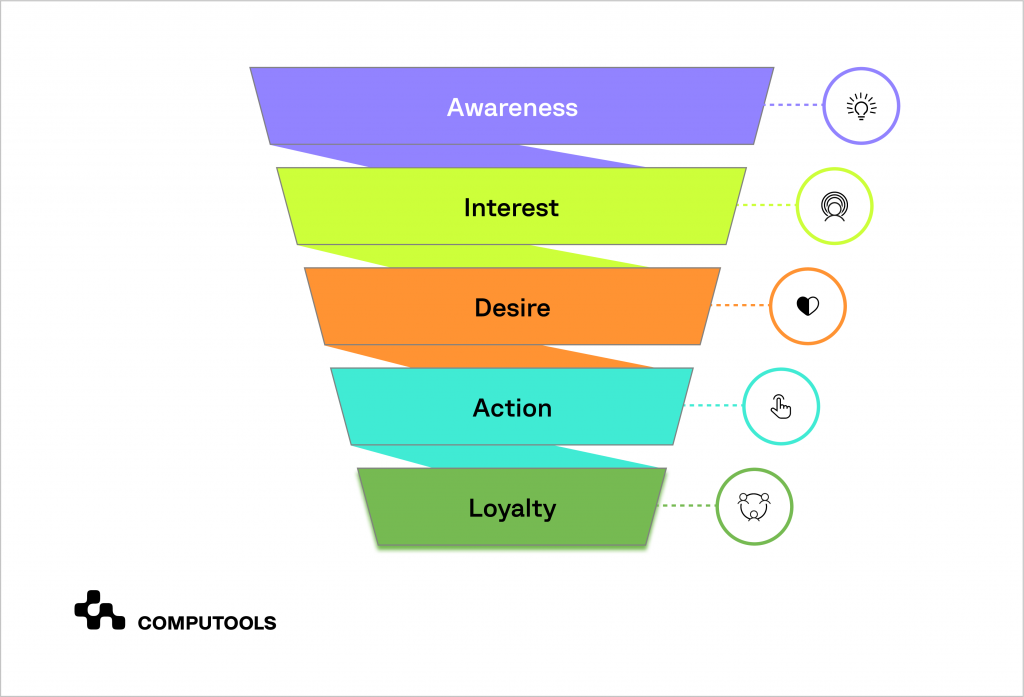Many people see a business website conversion funnel as a simple process where someone either calls, fills out a form or makes a purchase.
However, it’s not just about getting a single ‘yes’; it’s about guiding a person through a series of small decisions that lead to the final conversion.
Recent research indicates that, on average, only 3.65% of visitors on e-commerce websites take the desired action. This means that out of every 100 visitors, only about 4 end up making a purchase or doing what the website wants them to do.
Even if your marketing strategy brings a lot of visitors to your website, if your conversion funnel isn’t strong, it’s challenging to turn those visitors into paying customers.
To make the most of your marketing efforts, it’s important to improve the user journey and ensure that the process from visiting your site to making a purchase is smooth and effective.
In another article, we’ve already discussed web design principles to drive leads, addressing topics on how to construct a website to attract more customers.
Now we want to focus more on marketing efforts and engaging with the audience. Let’s dive in.
What Is a Website Conversion Funnel?
A conversion funnel, also known as an online sales funnel, is the method you use to attract potential customers to your website and guide them towards taking the action you want them to take.
It consists of five stages, and even though it may seem simple, it plays a key role in determining the success of your online business sales.
Five Conversion Stages
Before we dive into tips, let’s first clarify the stages of the website sales funnel, as each stage shapes user perceptions and influences engagement.
1) Awareness
To create a conversion funnel, you must initially draw people into your sales funnel by generating awareness about your products and services. Social media and PPC advertisements can effectively introduce users to your products.
2) Interest
Once prospects enter the funnel, the goal is to cultivate their interest in the offerings. At this stage, website content becomes the key player.
Quality content positions the business as an authority and various formats like blogs, videos, guides and resources help users better understand the offerings.
3) Desire
With their interest captured, the next step is to intensify their interest in the services and products.
This involves explaining why they need what the business offers, emphasising the uniqueness of the solution compared to competitors and transforming interest into a desire.
4) Action
At the bottom of the conversion funnel, prospects become customers by making a purchase or hiring services. These leads have completed their research and are ready to take action.
5) Loyalty
Converting a lead into a customer isn’t the end goal. The focus shifts to bringing back repeat customers and building brand loyalty.
Ensuring each customer has a positive experience, even if there are temporary issues, contributes to long-term customer relationships and can be more cost-effective than acquiring new customers.

7 Steps To Build Effective Website Conversion Funnel
Developing an effective marketing funnel requires effort and doesn’t happen overnight, but the long-term benefits are worth it.
A well-crafted website conversion funnel can significantly maximise sales and profit. Here are the most important steps to create one.
Step 1: Map out the customer journey
Understanding user behaviour on your website is key to building an effective optimisation strategy. Monitor your sales funnel to gain insights into how visitors navigate your website or e-commerce store.
While visualising the five stages of a website conversion as a funnel is helpful, mapping out the ideal customer journey process provides a more detailed understanding.
A customer journey map typically reveals pages visited, user behaviour on those pages, how the site makes them feel and challenges encountered at each stage.
Here are some practical things to do.
• Identify key personas: start by defining your ideal customer personas based on demographics, interests and behaviours. This helps in understanding different user needs and preferences.
• Outline key steps: for each persona, outline the steps they take from discovering your website to making a purchase. Include entry points (e.g. organic search, social media), pages visited, actions taken and exit points.
• Identify touchpoints and pain points: highlight key interactions with your website and any obstacles or challenges customers face at each stage.
Step 2: Capture user interest through content
Your website content plays a major role in capturing user interest and desire. Regardless of how top-tier your products or services are, if your content fails to evoke interest, it won’t matter.
Tailor your content to your niche and target audience, ensuring you cover each stage of the conversion funnel.
Recommended content for each stage includes the following.
• Awareness stage: blog posts, email newsletters, how-to videos and infographics
• Interests and desires: customer testimonials, case studies, demo videos and catalogues
• Action and loyalty: free consultation, free trial, coupon and pricing page
Step 3: Craft a Visually Engaging Homepage
Develop an aesthetic, functional, intuitive and captivating homepage with human-centred design.
Ensure it loads in less than three seconds, features essential information at the top left corner and guides visitors through the funnel with high-quality visuals and concise copy.
Here’s a list of elements and best practices to consider when opting for web development services.
• Colour scheme and typography: choose a colour palette and fonts that reflect your brand identity and are easy on the eyes. Consistency in these elements supports brand recognition.
• Clear value proposition: immediately convey what your brand offers and why it’s unique, ideally above the fold (the portion of the homepage visible without scrolling).
• Contact information: make it easy for users to find contact options, including a phone number, email or chat support, to foster communication.
• Interactive elements: include elements like hover effects, animations or interactive infographics that engage users without detracting from the user experience. This may be especially beneficial for a web design sales funnel.
• White space: use white space to create a layout that doesn’t feel crowded, making it easier for visitors to focus on important content.
• Consistent branding: ensure all visual elements on the homepage align with your brand identity to create a cohesive look and feel.
Step 4: Prioritise and plan visibility
Theme your campaigns to individual product or service levels rather than directing visitors to a homepage with general brand messaging.
Create themed campaigns for each important product or service and diversify targeting across organic and paid channels, depending on your target audience’s buying journey.
To support your efforts, consider these strategies.
• Segment your audience: group your audience by demographics, considering factors like age, gender, income and education. Tailor messages specifically for each demographic segment.
Additionally, take into account regional preferences, languages and cultural nuances to ensure your marketing approach is highly personalised.
• Lead capture mechanisms: include forms to capture leads in exchange for valuable resources like whitepapers, free trials or demos related to the product or service.
• SEO (search engine optimisation): optimise your website and content for keywords related to each product or service to improve visibility in search engine results.
• Email marketing: segment your email list and send personalised emails that align with the themed campaign, offering exclusive content or promotions.
Step 5: Create effective calls-to-action
CTAs are very important in guiding visitors through your online sales funnel. Keep them concise, clear and action-oriented, using language that creates urgency.
Optimise their placement on your website, considering strategic positions at the end of product descriptions or prominent locations throughout landing pages.
Step 6: Implement trust signals
Trust signals are also essential to instil confidence in potential customers. Display customer reviews, testimonials, security badges and certifications throughout your sales funnel.
Social proof, such as showcasing the number of satisfied customers or followers on social media, reinforces trust.
Step 7: Implement customer loyalty programmes
Reward customer loyalty with exclusive discounts or promotions to increase retention and drive repeat purchases.
Consider a tiered loyalty programme based on purchases and engagement, enhancing the perceived value of the customer’s relationship with your business. Track and analyse the effectiveness of loyalty programmes for data-driven improvements.
Examples of Successful Conversion Funnels
While a well-crafted theory holds value, practical experience trumps it. After analysing three successful cases of business website conversion funnel, let’s explore the specific elements that actively contribute to making their strategies effective in attracting customers.
1. Basecamp
Strategy: Basecamp combines a personal touch with strong social proof, emphasising customer problems it can solve. It integrates emotion deeply into its sales funnel, shaping the tool not just as a service but as a part of the buyer’s identity.
Unique Elements: Basecamp’s funnel stands out through continuous A/B testing and creatively displaying social proof. It speaks to customers on a natural level and consistently evolves with the market.
Success Factors: The funnel achieves effectiveness by emphasising testimonials, providing a free trial without requiring credit card information and presenting pricing information with clarity.
2. Groupon
Strategy: Groupon relies heavily on its email list, using a clear and prominent email opt-in pop-up to grow its audience. This strategy has been effective in expanding the audience over the years.
Unique Elements: Groupon’s website sales funnel lacks free trials but delivers immediate value through discounts upon email sign-up. Its model can be viewed as an email list with an attached website, concentrating on deal-driven customer engagement.
Success Factors: Tailored follow-up offers, particularly geared towards their larger female customer base and incentives for signing up contribute to the effectiveness of its funnel.
3. Netflix
Strategy: Netflix adopts a straightforward and flexible approach, highlighting easy cancellation and clear information. This approach reduces perceived risk and centres on consumer security and convenience.
Unique Elements: The strength of the Netflix brand, along with multiple payment options and the ability to contact them by phone, sets its funnel apart. It builds trust and caters to the risk-averse nature of consumers.
Success Factors: Key to Netflix’s funnel effectiveness are a simple site design, a clear cancellation policy and an emphasis on security. The minimalistic approach in presenting information helps maintain the focus on consumer ease and confidence.
Additional Tips to Optimise a Conversion Funnel
Apart from the steps we’ve discussed earlier, it’s important not to overlook additional optimisation strategies.
Working with a proficient web development company that provides subject matter experts can significantly reduce your workload and ensure successful task completion.
Here’s how you can improve your optimisation strategy further.
1. CRM and automation
If you’re capturing lead information and using nurturing techniques like email marketing, make use of software that allows you to manage and automate your campaigns.
Effective customer relationship management (CRM) and email marketing software play a key role in your website conversion funnel. They help track contacts and automate tactics like drip email campaigns.
2. Implement A/B testing
Creating an attractive and informative website that can generate leads is just the beginning. Continuously conduct A/B testing on different elements within the lead funnel, including headlines, CTAs and layouts.
Analyse the results to make data-driven adjustments that improve user interaction and conversion rates. Extend your A/B testing to include email campaigns and in-store displays.
3. Social Media Promotion
To optimise your sales funnel, engage in essential social media promotion. Use platforms like Facebook, Instagram and LinkedIn to reach and engage with a broader audience.
Craft compelling social media content that resonates with your target market, providing valuable insights or exclusive offers. Employ eye-catching visuals and concise captions to capture attention and direct traffic to your website.
Final Thoughts
Understanding how the business website conversion funnel operates can improve the user journey and help to attract more leads, convert them into customers and, ultimately, boost your profits.
Achieving this involves minimising any obstacles in the process. Identify what works for your specific sales cycle, use your existing content and channels to stay connected and make sure customers value your business, encouraging them to come back.
If you want to learn more about conversion funnel optimisation, reach out to us via email at info@computools.com.

Computools
Software Solutions
Computools is a digital consulting and software development company that delivers innovative solutions to help businesses unlock tomorrow.









“Computools was selected through an RFP process. They were shortlisted and selected from between 5 other suppliers. Computools has worked thoroughly and timely to solve all security issues and launch as agreed. Their expertise is impressive.”